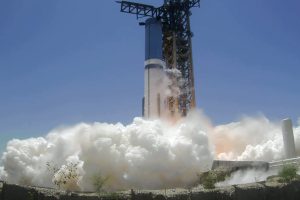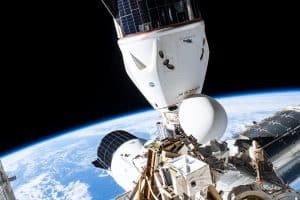- 🚀 Blue Origin’s New Shepard rocket launched its first crewed mission since September 2022.
- 👨🚀 The mission, NS-25, carried six private citizens to space and back.
- 🌌 The crew reached an altitude of 351,111 ft (107 km) and a top speed of 2,236 mph (3,599 km/h).
- 👴 Ed Dwight, aged 90, became the oldest person to fly to space on this mission.
- 🪂 Only two out of three parachutes on the crew capsule inflated during landing.
- 🛬 The flight demonstrated that a safe landing is possible even with a parachute issue.
- 🔍 It’s unknown if the FAA will investigate the parachute malfunction and if it will affect future launches.
Blue Origin, the private aerospace manufacturer and sub-orbital spaceflight services company, has marked a significant milestone with its recent crewed mission. After a hiatus since September 2022, the company’s New Shepard rocket has successfully launched and returned from a suborbital journey, carrying six private citizens into space. This mission, known as NS-25, not only showcased Blue Origin’s commitment to safety and innovation but also set new records and provided invaluable learnings for the future of space travel.
The Journey of New Shepard: A Landmark Event
The Significance of the NS-25 Mission
On May 22, 2024, Blue Origin’s New Shepard rocket lifted off from its West Texas Launch Site One. This mission was particularly noteworthy as it was the first crewed flight since an incident in 2022, where a nozzle failure led to the activation of the flight termination system. The successful completion of NS-25 marks a triumphant return to crewed space missions for the company.
Crew and Journey Details
The mission carried six private citizens, who embarked on a journey that would see them reach an altitude of 351,111 ft (107 km) – surpassing the internationally recognized boundary of space known as the Kármán line. During their brief stint in space, the crew experienced the thrill of weightlessness and the stunning sight of Earth from above.
Here are some key details:
- Altitude Achieved: 351,111 ft (107 km)
- Top Speed: 2,236 mph (3,599 km/h)
- Flight Duration: Just under 10 minutes
Historic Achievements: The Oldest Space Traveler
A particularly inspiring aspect of this mission was the inclusion of Ed Dwight, a 90-year-old former U.S. Air Force Captain. Dwight’s participation in NS-25 set a new record, as he became the oldest person to ever fly to space. This milestone is especially poignant given his history; Dwight was selected to be a NASA astronaut in 1963 but did not fly at that time. His journey on NS-25 is a testament to the enduring human spirit and the relentless pursuit of dreams.

Ensuring Safety: Challenges and Triumphs
While the mission was successful, it was not without its challenges. During the landing phase, only two out of the three main parachutes on the crew capsule inflated. However, this contingency had been planned for, as Blue Origin had previously demonstrated that a safe landing could still be achieved using only two parachutes. The ability to safely navigate this scenario underscores the robustness of Blue Origin’s safety protocols.
Potential Investigations and Future Implications
Despite the overall success, the parachute malfunction may draw attention from regulatory bodies. It remains uncertain if the Federal Aviation Administration (FAA) will initiate an investigation into the issue and what implications this might have for future launches. Nonetheless, the successful mitigation of the problem during NS-25 provides confidence in the system’s resilience.
Looking Forward: The Future of Blue Origin
Blue Origin’s NS-25 mission has rekindled excitement and optimism for the future of commercial space travel. The success of this mission paves the way for more frequent and ambitious missions, possibly involving longer durations and higher altitudes.
Some Predictions and Insights:
- Increased Frequency of Flights: With the success of NS-25, Blue Origin is likely to ramp up the frequency of its crewed missions.
- Expanded Participation: The inclusion of private citizens and record-setting travelers like Ed Dwight highlights the inclusivity and accessibility of future space travel.
- Technological Innovations: Continued improvements in safety and technology will be paramount, ensuring that any future anomalies can be effectively managed.
Conclusion: A New Era for Blue Origin
The successful launch and return of New Shepard on the NS-25 mission signifies a bold step forward for Blue Origin and the commercial space industry. As the company looks ahead, the lessons learned and achievements made will undoubtedly shape the future of space travel, making it safer, more accessible, and increasingly awe-inspiring.





